|
This review page is supported in part by the sponsor whose ad is displayed above
|
|||||||||
 |
|||||||||
| WLM's new Duo amp with its inbuilt 80Hz low-bass filter, bass EQ and dual-mono level controls wedded to the 2-way System Control IV can henceforth replace the more complex Sys V version of the electronic brain in many applications. If you never meant to go subwoofing but listen to your WLM speakers full range, you didn't need System Control V. Just so and anticipating future bass lust, WLM had always outfitted their modular Sys IV with a prewired card slot. One could thus add Sys V subwoofer functionality later. Because System Control IV + Duo amp equals the functionality of System Control V, Sys IV now accommodates 3-way use. However, you couldn't change bass amplifiers later unless they too were equipped with their own low-pass filter and gain control. Enter self interest. I already owned a Duo 12 with the older Class A/B Alto Mac 2.2 bass amp. I wanted to upgrade to the new Class D Duo amp whose absence of forced-air fan cooling would make for completely silent operation, something I'm a stickler on. For this review, WLM thus only needed to send the System Control IV with my new amp. My older Duo sub had the bridged Alto Mac 2.2 amp drive its twin woofers paralleled and in mono, from a single binding post pair. The new Class D Duo amp cannot be bridged. Hence going forward, Duo subwoofers are stereofied, with each woofer wired to its own terminals for discrete l/r-channel bass from a single enclosure. I thus also ordered a new biwire terminal plate for my Duo 12 and rewired it for the new amp (which, WLM is happy to admit, is once again sourced from Alto as their A500.2 Dragonfly 2 x 480w/4-ohm unit but subsequently rather modified in Austria and outfitted with WLM's own face plate, filter, EQ circuit and controls). |
|||||||||
 |
|||||||||
To allow commentary on new versus old bass amp -- and to also run yet other amps on the subwoofer -- WLM did send the more complex System Control V after all. Bypassing its bass output, the new Duo amp would run straight off the second output of my preamp. Using Sys V's bass feed, I could run any stereo bass amp in my arsenal to critique the new Class D amp not merely vis-à-vis the older Alto model but also against high-end muscle amps (of which, incidentally, I had some exceptionally brute but refined specimens enroute for another review assignment). One audio myth proclaims pro-arena amps like Crowns unfit for bass duty in the home. Golden ears state the superiority of class A amps from the bona fide hifi sector. Needless to say, WLM considers this a myth in dire need of two black eyes. Not invested in the subject -- except to prefer less expensive to more expensive solutions if they do the job as well or better -- I signed on for adding an American-style bass amp shootout to this final chapter in the WLM saga. [As the above photo shows, Hannes Frick is no stranger to shoot outs though he's clearly a polygamist at heart - and one with a well-stocked vinyl and tape inventory.] |
|||||||||
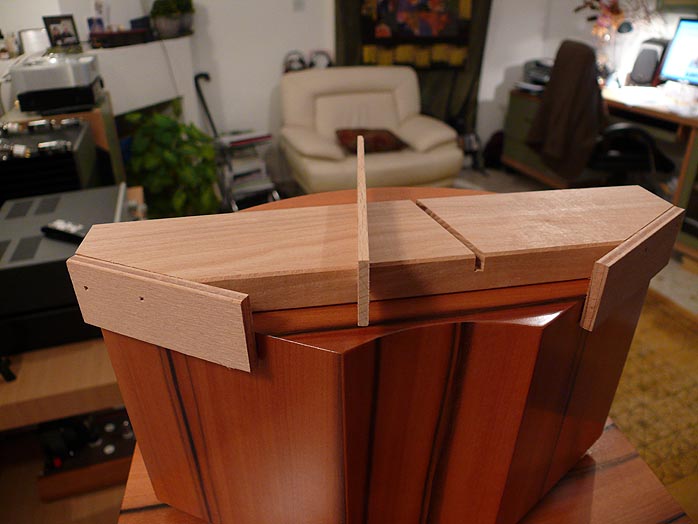 |
|||||||||
Setup Being equipped with a SuperPAC treble system has two practical consequences. A/, the speakers arrive as clearly marked left and right specimens (refer next to the serial number on the terminal plate for the designator) - they should not be reversed. B/, the speakers must be aligned such that the included asymmetrical directionality jig aims straight at the listening position. Only when these directions are followed will the tweeter system work as advertised. Using a bright flashlight for a look-see behind one perf tweeter grill revealed two circa 2-inch paper cone drivers with dust caps, loaded into some kind of generously flared wave guide each and then angled outwards away from each other. |
|||||||||
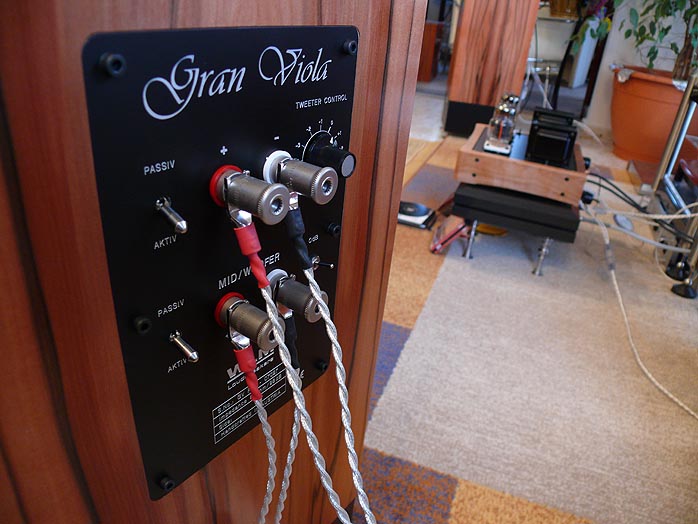 |
|||||||||
In active mode, the internal crossover is bypassed. System Control IV or V then insert between your preamp and the two stereo or four mono amps dedicated to biamping the speakers. A thoughtful feature is the spring-loaded sleeve on each passive/active toggle. You cannot accidentally move it. You must pull before it will switch. Smart. |
|||||||||
 |
|||||||||
The new Duo amp combines dual-mono front-mounted gain controls, convertible hi/lo inputs and WLM's bass EQ. For connectivity from your preamp, you'll either want an RCA interconnect with ¼" plugs on the load end or you could use the provided RCA adaptors shown in the photo below. The speaker cables connecting to the subwoofer want to see SpeakOns for the source, something WLM will happily supply by request. |
|||||||||
 |
|||||||||
System Control V ingeniously connects three discrete metal modules via lateral spacers and box-to-box cross wiring. This cuts down on the active RCA terminals 'round back. There's one low-level input for your preamp and three outputs for each frequency band - SuperPAC treble, twin 10-inch mid/bass and the optional subwoofer. The power supply section sports a thoughtful power outlet should you wish to use System Control as central power switch. In that case, there's an inbuilt 30-second delay after powering off all connected electronics from their power strip before the WLM brain retires. This prevents turn-off thumps especially with tube amps which often drain slowly. The optional remote adjusts both treble and mid/bass gain for arm-chair voicing. |
|||||||||
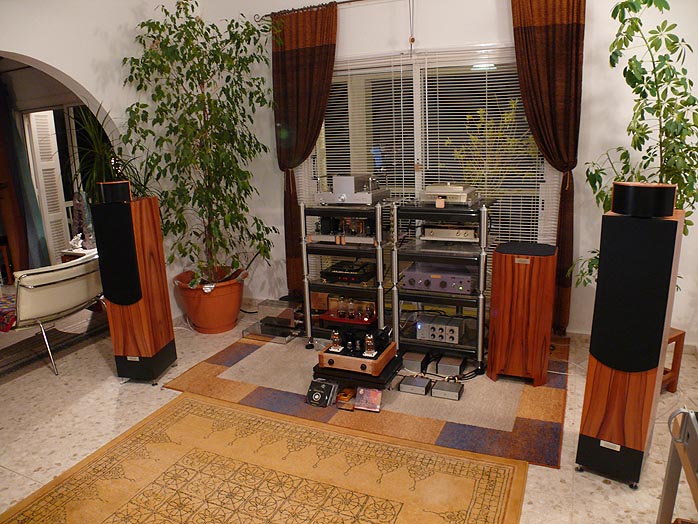 |
|||||||||
Once installed, the Grand Viola cuts a Living Voice-style profile with its blacked-out plinth that cleverly hides the large-diameter downfiring port. That port is a twin-sleeved affair, with a short master sleeve screwed into the plywood recess and a longer one of slightly larger diameter slipped onto it. By undoing six wood screws, one can remove the longer port sleeve and remount the short one to experiment with bass loading. The speaker enclosure with the long port is tuned to 25Hz but port conversion can alter the bass alignment. In general, the longer pipe as delivered creates leaner, drier and 'faster' bass. The shorter pipe increases output and weight to an extent that could be counter indicative for the majority of rooms. It's not a fully predictive affair and experimentation is necessary to determine the optimum arrangement. |
|||||||||
 |
|||||||||
| This is yet another in a long line of practical features which make this | |||||||||
| speaker unusually adaptable to various environments. Make no mistake, that's the dividing line between believers and the unfaithful when it comes to the WLM church. Where the faithful celebrate intuitive, non-PC adjustability, the nonbelievers wield their charms and amulets. They push you towards the same cemetery where mono switches, tone, loudness and balance controls got buried with the last pharaohs. The grills come off easily and leave rather small black plastic retainers in the fascias. The book-matched veneer work is of the highest quality and even mirror-images the respective insides and outsides of each speaker, something one comes across very rarely. |
|||||||||
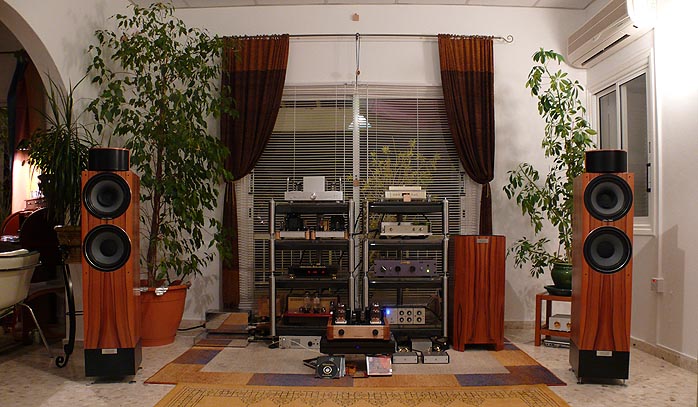 |
|||||||||
Due to the recommended formula of speaker to speaker distance relative to the listener (1.5 : 1), I increased the former by two feet over my standard setup, running into limitations of course due to my fixed short-wall orientation but maximizing the staging strengths inherent in this design as much as I realistically could accommodate. |
|||||||||
 |
|||||||||
The great freedom of active tri-amping caused quite a few mental somersaults. To exercise my newly acrobatic self, I kicked off by leashing my Yamamoto A-08S on the treble, the Almarro A318B to the mids and my AudioSector Patek SEs bridged to 100-watt mono on the rewired Duo 12. Preamp duties were handled by Wyetech Lab's Jade and source duties by the Ancient Audio Lektor Prime feeding digits to the Stylos Sys Had D/A converter. Direct-heated 45 triodes. High-current 6C33Cs. ICs. Shaken or stirred? I don't give a damn. Bond, James Bond. Purists would shudder in their hair shirts. Actual experience would too - in delight. Where to begin? With more general observations for starters. The performance/value equation WLM's subwoofers and active networks operate on such an exalted niveau and integrate so seamlessly that their best floorstander can't compete. Even the affordable Diva Monitor crossed over to my Duo 12 outperformed the Grand Viola in that regard. Granted, not all audiophiles are liberated enough from conditioning to accept such a statement. But their countless encounters with inferior subwoofers rather do justify their reluctance, from real experience no less. On principle, they won't consider external bass systems. The Grand Viola Signature MkII then becomes the ultimate WLM - if you're prepared to go active. Otherwise, the Lyra Signature MkII with its dual 8s will offer the most favorable diminishing return factor which explains why it continues to be the bestselling WLM model. Its smaller widebander might actually hold certain aces in the vocal range compared to a passive Grand Viola, countered naturally by slightly reduced bass scale. For ultimate Grand Viola performance, I reverted to tri-amping. Needless to say, that throws away the money spent on extending the speaker to 25Hz in the first place. For listeners like myself who are convinced that outboard bass systems done properly are the ultimate, the fully active WLM dream system for the best price will either be an Aura Monitor Signature package (€14,880 with Basic Duo + Sys IV + Duo amp) or the Grand Viola Monitor equivalent (adds €900). Comparing my Diva Monitor to the floorstander, it's apparent that the smaller box volume creates higher self-damping of the widebander in the critical upper bass/lower midrange band. This affects the impulse response and hence, transient accuracy. The smaller speaker produces more audible pressure and jump factor in that region. If you fancy that, a WLM monitor/sub system is key and I'll put my money on that. I'll trade up to a GV Monitor (due to the Legend driver's greater motor depth, the Diva unfortunately can't be converted into a GV monitor). With an active Grand Viola starting at €11,700 in the three basic veneers, going the 3-piece route with a WLM monitor clearly means greater expense. That makes the floorstander an excellent option for less than ultimate bass freaks. |
|||||||||
 |
|||||||||
Bass amps Switching between regular amps and WLM's Diva amp was child's play. The latter remained connected to my preamp's second pre-out, the former to the Sys V's output. With discrete speaker cables on either amp, I merely had to change the leads at the subwoofer terminals. The results were instructive. If you drive the Grand Viola with triodes which the tailored bandwidth limiting of active drive strongly encourages, Class D or pro-arena muscle amp with huge current and ultra-low output impedance on the bass will create transient discontinuity. The subwoofer band will be overdamped and supernaturally articulated to telegraph striations like a bodybuilder at show time who, with a tough regime of body fat and fluid reduction during the last days prior to competition, achieves that hyper-chiseled cut look which (I've lived on Venice Beach to know) he normally doesn't. Tube amps don't striate. While ripped bass has incontestable virtues, a sophisticated listener will want seamless continuity and coherence. That'll mean running the mains on equivalent transistor amps as well. With tubes, some of the textural differences can be minimized by tweaking the lower controls of the active crossover. Other listeners will lean toward the warmer, rounder, less attack-driven behavior of my Audio Sector monos or equivalents. On challenging Trance/Ambient, Reggae, HipHop and Techno however, Class D muscle makes some very compelling arguments for itself. To take a definitive position on these differences is thus fraught with ambivalence and will also depend on the kind of musical fare you listen to. |
|||||||||
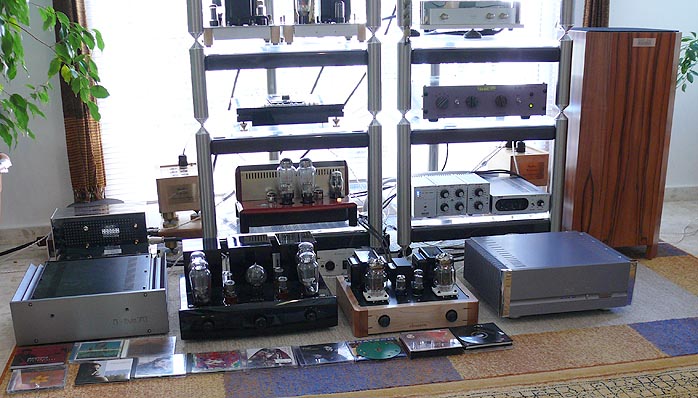 |
|||||||||
In the muscle realm, WLM's new Duo amp not only operates quieter than the previously recommended Mac 2.2, it also beats it in the drive/control sweepstakes. For many people, it will be the perfect solution. It runs cool and is sized demurely to fit on the same shelf as WLM's crossover brain (shown above). However, class D, at this level of execution, remains clearly overshadowed by a superior conventional class A/B amp like Coda's 330wpc CSX with its humongous 3kVA toroidal power transformer. And yes, it's a $6,000 premium amp squandered on subwoofer duty. However, for a reviewer graced with short-term loaners, the operative motto remains, 'flaunt it if you've got it'. In this instance, the results were the warmth and roundness of the chip amps coupled to the iron-fisted control of the Diva amp - without those bothersome striations which are unnaturally etched attacks. The moral of this experiment seems to be, more power for the bottom two octaves is better - if it's quality power to begin with. Driving the Grand Viola full-range ideally requires a more potent amp than the 97dB sensitivity rating might suggest. Unlike Zu's Definition which relegates the most challenging low-bass transients to a separately driven bass array, the WLM tower runs its main amp from 800Hz all the way down into the basement. I did not find the 18wpc Almarro A318B capable of convincingly controlling the bass though desired SPLs were not the issue. The headroom of articulation, grip and extension left untapped as compared to the subwoofer feed was simply too significant. Considering, there were no real surprises there. For full-range drive, think about 50 watts for the Grand Viola's main amp. However, the 800Hz-on-up coverage of the tweeter system was terrifically handled even by something as flee-powered as Yamamoto's wonderful A-08S 45 SET. The Almarro meanwhile was fabulous when not asked to handle the bottom two octaves. Bandwidth limiting is the ticket here. |
|||||||||
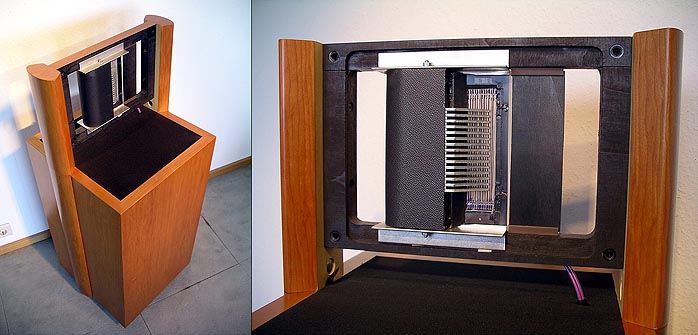 |
|||||||||
Treble The SuperPAC is rather more than a conventional tweeter when you consider its low 800Hz crossover transition. That's far from a brickwall filter but creates diminished output significantly lower still, easily appreciated in active mode when you mute the mid/bass amp. What's more, the SuperPAC's dispersion pattern and phase behavior, once aligned as instructed, give center fill, holography and layering new meaning. Besides the obvious -- large-scale symphonic -- this is particularly fascinating on artificially crafted soundstages by studio mavens like Mercan Dede who very deliberately people their stage with 'extrasensory elements' (call them soundtrack tricks) which wouldn't occur on regular live stages. The extent to which even very tiny effects now reveal their precise location and character (or movement and phase trickery) as well as microdynamic transient and decay action is quite astounding. Powerful proof that this dimensional accuracy wasn't imaginary occurred each time I sat behind my Samsung computer monitor which faces me against the left long wall of the listening room. Though this puts me in line with the left speaker and thus massively off axis with the right (never mind significantly closer to the former), the soundstage, while slightly skewed to the left, still remained surprisingly stable between these WLMs. Though not quite an omni effect, it also lacked the somewhat diffuse focus of true omnis. In short, SuperPAC action is rather akin to an otherwise non-existent ultra-focus omni. It's not a completely accurate descriptor but close enough to convey the impression of gargantuan staging with superior image specificity and a very wide, stable sweet spot. The quality of the treble is ultra smooth, dynamic and supremely informative all at once. By comparison, the Diva Range tweeter is slightly coarse and the Zu treble (which enters fully at 12kHz) far less resolved. [Interestingly, Frick also loves Oscar Heil's original dipole AMT though he feels that, in his Kithara shown above, the transition to the bass wasn't fully realized. He further admires the mbl 101 for its top end despite a potential for getting steely and hard. The connection is clear - wide-dispersion high frequencies of superior speed are a WLM obsession.] |
|||||||||
 |
|||||||||
The brain System Control's six knobs are best thought of as volume pots for the upper three and Quad-style tilt tone controls for the lower three. The exact network slopes and compensation curves remain undisclosed but are hinted as being progressively linked 2nd and 4th-order types. Hannes Frick calls Martin Schützenauer a linker Bursche in that regard - wired backwards. It points at unconventional solutions not covered in the text books. They become fully germane only to other gifted engineers who think outside the box and tie their shoe laces from top to bottom. WLM's excellent instructions provide for quasi default settings to get you started. Still, the emphasis is firmly on "twirl, learn and trust your ears". It's a commandment as alien to most career audiophiles as thinking for themselves is to army grunts who are still shell-shocked from boot camp. [Martin has even authored the MultiChannel Preamp above which, passively, creates 4.0 surround to play back superior Pentatone and related software where the rears are encoded purely for ambience. On that particular count, Frick feels his beloved analog finally comes up short against digital by simply not providing this level of information. His domestic setup below.] |
|||||||||
 |
|||||||||
Brainwashing Pointing at his Studer A80 below or machines like the Cello Palette, Manley Massive Passive or EAR 825Q, Frick doesn't get naysayers who wield signal purity as though such machines violated it. He knows he can make even lesser electronics and rooms sound good when empowered with his own flexible adjustments. As recounted earlier though, even many of his own dealers don't embrace active drive and compensation circuity. Due to prevailing audio experts, such features remain decidedly audiophile-unapproved. Why retrain your customers who have formed strong beliefs which one can sell to with far less effort? Enter the demo - or A/B comparison in our case. Would active drive sell itself? For an even-handed comparison, amplification would remain identical, possible because my main amps were integrateds (or quasi integrateds with passive attenuators) to offset the gain disparity between tweeter and mid/bass amps. |
|||||||||
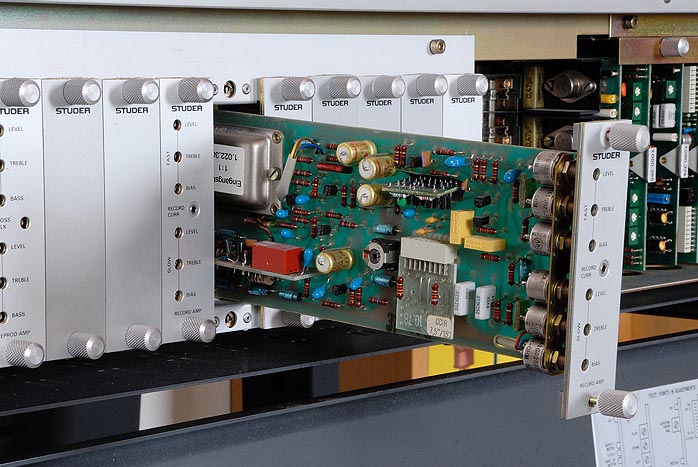 |
|||||||||
 |
|||||||||
 |
|||||||||
 |
|||||||||